Course Overview
Welcome
to Social Studies 170!† Throughout the
thirty-six units of this course, you will study a wide variety of events,
people and decisions that have not only affected our past but that directly
influence our present and future.† From
Ancient Greece to the First Global Age, you will explore how the world changed
and evolved.† It will help you to
understand the global community in which you live and to process information.† Experiencing this form of time travel and
discovering why people behaved as they did can be fun.† Letís get started!
 IN AND AROUND THE AEGEAN SEA
IN AND AROUND THE AEGEAN SEA †
†
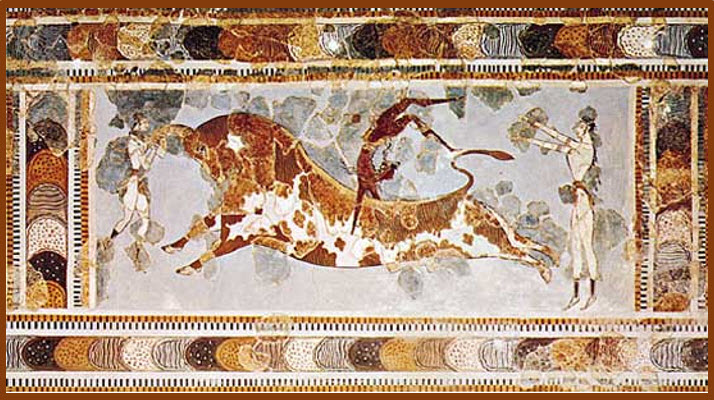
Fresco
Painting from the Palace of Knossos
†
Unit
Overview†††
Although
Greek civilization began in a small corner of Eastern Europe, it had and
continues to have global impact.† It
began with early societies on the island of Crete with a people known as the
Minoans and on the Greek mainland in the city of Mycenae, which we would
probably view as more of a town. What do we know about these people and how did
we learn it?† Do we know all about them
or are their still mysteries to solve?†
Letís find out!†
The
Minoans and the Island of Crete†††
The
Aegean Sea is home to a large number of islands, but Crete is one of the most
famous.† A brilliant and significant
early civilization grew here and reached its greatest success from 1750 B.C. to
1500 B.C.† The people who built this
civilization were called the Minoans by Sir Arthur Evans, a British
archeologist who unearthed the ruins of their buildings during the early
decades of the 1900s.† He based the name
on the islandís legendary King Minos and became an early pioneer in the field
of archeology in the area surrounding the Aegean Sea.
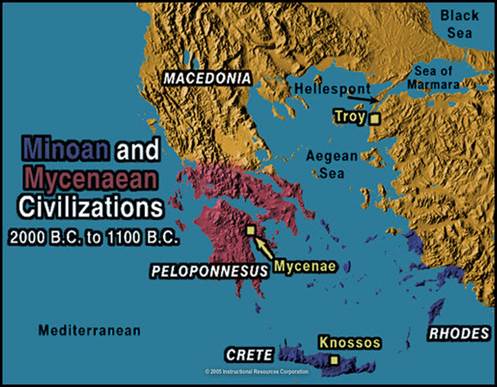
Unlike
other ancient civilizations, the Minoans did not achieve their success through
conquest but became traders instead.†
They set up outposts in the lands touched by the Aegean Sea and came
into contact with other people, such as Egyptians and Mesopotamians.† By sailing to different ports in the region,
they not only acquired objects from other cultures but also gained new ideas
and technology which they adapted to their own culture.† This process is called cultural diffusion; it
spreads different products, concepts and customs from one group of people to
another.† Click on the icon below and
watch the video segment to learn more about the Minoans.††
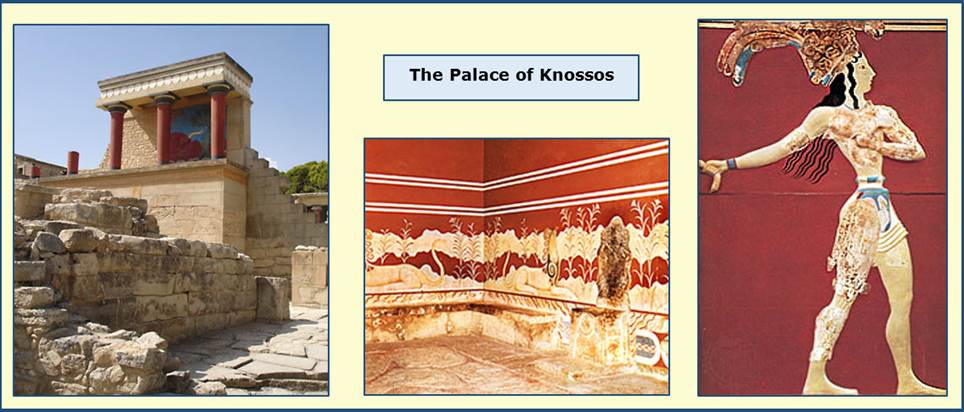
One
thing we do not know about the Minoans, however, is how their civilization
ended.† By 1400 B.C., it appears to have
vanished.† Was it destroyed by a volcanic
eruption or a deadly earthquake followed by a tidal wave?† We simply do not know.† Maybe you will become the archeologist who
solves this mystery.† In the meantime, we
are certain that the palace was invaded and raided by the Mycenaeans, the first
Greek people to leave written records of their history.
Mycenae
and the Trojan War†††
From
1400 B.C. to 1250 B.C., the Mycenaean civilization controlled the Aegean
world.† They, too, were sea traders, but,
unlike the Minoans, they traveled beyond the Aegean realm to Sicily and Italy.† The Mycenaeans learned the art of writing
from the Minoans, and they passed this skill to others living on the Greek
mainland.† Mycenaean warrior-kings
established separate city-states and built thick-walled forts for their
protection.† Archeologists have uncovered
gold ornaments and other treasures from their tombs.† It was their interest in trade and valuable
objects that brought the Mycenaeans into conflict with the wealthy city of Troy,
once located in the modern-day country of Turkey.† Although most historians agree that Troyís
control of the straits between Black and Mediterranean Seas was the cause of
the controversy, legends gave the war a romantic twist.† When Paris, a Trojan prince, kidnapped Helen,
the beautiful wife of a Greek king, the Mycenaeans recruited soldiers from
Greece and sailed to Troy to reclaim her.†
The two sides battled for ten years, but the Mycenaean forces eventually
burned Troy to the ground.†
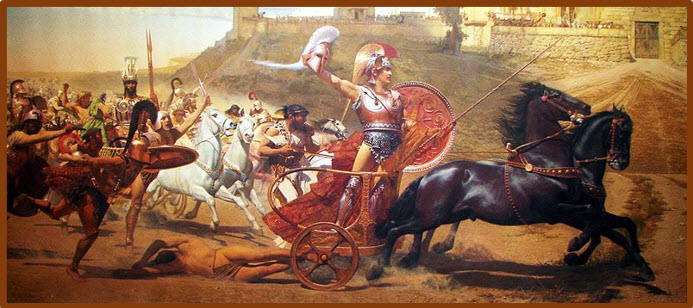
An
Artist's View of the Trojan War Centuries Later:† Franz Matsch, 1892
For
centuries, historians regarded the Trojan War as a product of folklore, but
this view changed in the 1870s.† Heinrich
Schliemann, a wealthy German businessman, was determined to prove that the
stories of the Trojan War were not purely fictional.† He conducted excavations at the sites of
ancient Troy and Mycenae.† Although he
drew several conclusions that eventually proved to be incorrect, Schliemannís
work convinced most scholars that the Trojan War was actually an historical
event.† You can view the ruins of Mycenae
as they look today by clicking the icon below and watching the video.†
Ancient
Greece and the Dark Ages†††
The
success of Mycenae in the Trojan War did not, however, ensure the cityís
long-lasting power in Greece.† Its wealth
soon attracted raiders from the sea and invaders known as Dorians from the
northern regions.† As the attacks
increased, Greeks abandoned their cities and lived in small, isolated
villages.† They lost interest in trade
and had very limited contact with the outside world. †Between 1100 B.C. and 800 B.C., their
civilization appeared to slide backward.†
For this reason, historians later referred to this era as the Dark Ages.
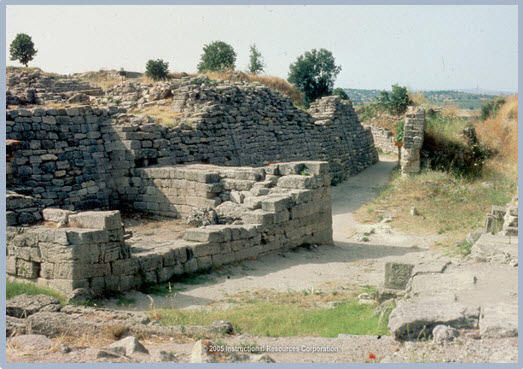
The
Ruins of Ancient Troy
Much
of what we know about life during the Dark Ages comes from the Iliad and the Odyssey, the two great epic poems of Greece.† Epic poems are long poems that describe a
series of events on a grand scale.†
Although the poet Homer is credited as their author, some scholars
believe that they are the work of several different writers.† Traditionally, Homer has been described as a
blind man who traveled from village to village and orally passed on stories
about the Greek heroes and their adventures.†
The Iliad concentrates on the
Trojan War from the Greek point of view and emphasizes the impact of the gods
and goddesses on its outcome.† The Odyssey tells the story of the long
voyage endured by the Greek warrior Odysseus when he turned to his homeland
after the fall of Troy.† To see what the
actual poem is like, read the opening lines of the Odyssey pictured in the graphic below.† You can also learn more about the exploits
described in the poem by clicking on the icon and watching the video.† Because they stress the values of courage,
loyalty and honor, the Iliad and the Odyssey have inspired writers and
storytellers for over three thousand years.†
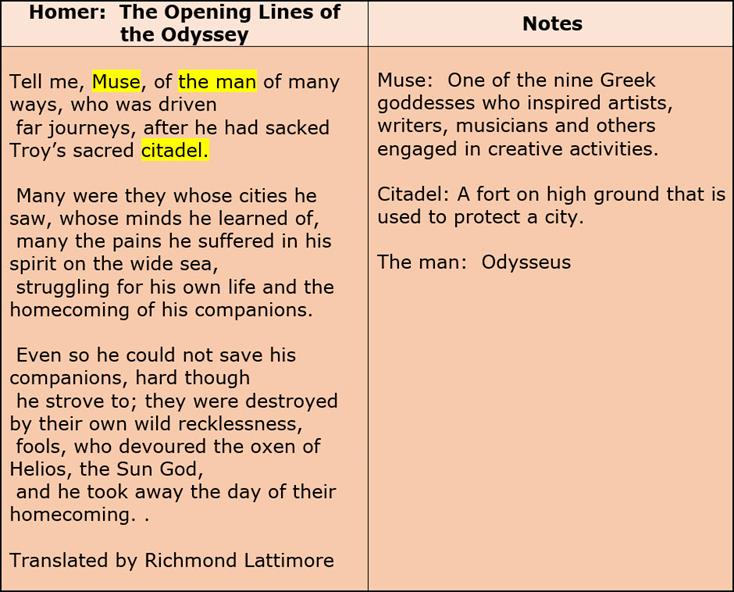
A
History Mystery:† The Mask of
Agamemnon†††
The
Mask of Agamemnon, pictured below, is an artifact that was discovered in 1876
at Mycenae by the archaeologist Heinrich Schliemann.† In Greece, Egypt and other areas of the
ancient world, funeral masks were sometimes crafted and placed over the face of
a royal body at the time of burial.† This
particular mask is made from gold and is about twelve inches in height.† Schliemann believed that the mask and the
body were those of Agamemnon, the legendary Greek king and leader of the Greek
forces in the Trojan War.† Since it does
not seem to match the styles of others found at the same site, some modern
researchers have disputed this claim and have argued that the mask is from a
much earlier time.† Other scholars insist
that the mask is a forgery, placed at the site by Schliemann to enhance his
reputation as an archaeologist.† Even
though the controversy continues and its authenticity remains in doubt, the
Mask of Agamemnon is a prized discovery and is on display at the National
Archaeological Museum in Athens, Greece.††
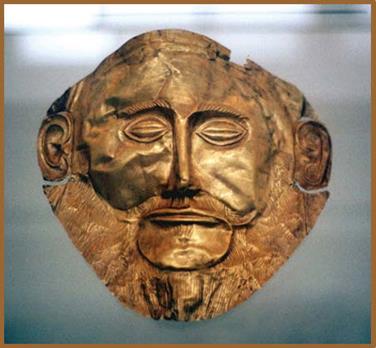
The Mask of
Agamemnon††††
What Happened Next?††
As
the Greeks slowly emerged from the Dark Ages, their geography shaped their
development.† It has been said that,
although the mountains divided them, the seas united them.† The Greeks traveled the Mediterranean and
Aegean Seas to connect with other people and to trade.† City-states expanded from villages to small
cities and developed forms of government.†
Although they were similar in some ways and held some of the same
values, each Greek city-state was unique.†
In the next unit, we will examine the two most powerful city-states,
Athens and Sparta.† How were they
alike?† How were they different?† What have we learned from them?† We will explore all this and more in the next
unit.† Before moving on to Unit 2, review
the information in this unit; then, complete Questions 21 through 30.